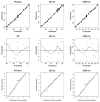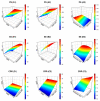Lipid Nanocarriers Overlaid with Chitosan for Brain Delivery of Berberine via the Nasal Route
- PMID: 35337079
- PMCID: PMC8955068
- DOI: 10.3390/ph15030281
Lipid Nanocarriers Overlaid with Chitosan for Brain Delivery of Berberine via the Nasal Route
Abstract
This research aimed to design, optimize, and evaluate berberine-laden nanostructured lipid carriers overlaid with chitosan (BER-CTS-NLCs) for efficient brain delivery via the intranasal route. The nanostructured lipid carriers containing berberine (BER-NLCs) were formulated via hot homogenization and ultrasonication strategy and optimized for the influence of a variety of causal variables, including the amount of glycerol monostearate (solid lipid), poloxamer 407 (surfactant) concentration, and oleic acid (liquid lipid) amount, on size of the particles, entrapment, and the total drug release after 24 h. The optimal BER-NLCs formulation was then coated with chitosan. Their diameter, in vitro release, surface charge, morphology, ex vivo permeability, pH, histological, and in vivo (pharmacokinetics and brain uptake) parameters were estimated. BER-CTS-NLCs had a size of 180.9 ± 4.3 nm, sustained-release properties, positive surface charge of 36.8 mV, and augmented ex-vivo permeation via nasal mucosa. The histopathological assessment revealed that the BER-CTS-NLCs system is safe for nasal delivery. Pharmacokinetic and brain accumulation experiments showed that animals treated intranasally with BER-CTS-NLCs had substantially greater drug levels in the brain. The ratios of BER brain/blood levels at 30 min, AUCbrain/AUCblood, drug transport percentage, and drug targeting efficiency for BER-CTS-NLCs (IN) were higher compared to BER solution (IN), suggesting enhanced brain targeting. The optimized nanoparticulate system is speculated to be a successful approach for boosting the effect of BER in treating CNS diseases, such as Alzheimer's disease, through intranasal therapy.
Keywords: biodistribution; brain targeting; coatings; intranasal; lipidic nanoparticles; nutraceuticals.
Conflict of interest statement
The authors declare no conflict of interest.
Figures








Similar articles
-
Formulation of intranasal surface engineered nanostructured lipid carriers of rotigotine: Full factorial design optimization, in vitro characterization, and pharmacokinetic evaluation.Int J Pharm. 2022 Nov 5;627:122232. doi: 10.1016/j.ijpharm.2022.122232. Epub 2022 Sep 23. Int J Pharm. 2022. PMID: 36155794
-
Surface engineered nanostructured lipid carriers for efficient nose to brain delivery of ondansetron HCl using Delonix regia gum as a natural mucoadhesive polymer.Colloids Surf B Biointerfaces. 2014 Oct 1;122:143-150. doi: 10.1016/j.colsurfb.2014.06.037. Epub 2014 Jul 2. Colloids Surf B Biointerfaces. 2014. PMID: 25033434
-
Coated Lipidic Nanoparticles as a New Strategy for Enhancing Nose-to-Brain Delivery of a Hydrophilic Drug Molecule.J Pharm Sci. 2020 Jul;109(7):2237-2251. doi: 10.1016/j.xphs.2020.04.007. Epub 2020 Apr 19. J Pharm Sci. 2020. PMID: 32320670
-
Navigating the Nose-to-Brain Route: A Systematic Review on Lipid-Based Nanocarriers for Central Nervous System Disorders.Pharmaceutics. 2024 Feb 27;16(3):329. doi: 10.3390/pharmaceutics16030329. Pharmaceutics. 2024. PMID: 38543223 Free PMC article. Review.
-
Nanostructured Lipid Carriers (NLCs): Nose-to-Brain Delivery and Theranostic Application.Curr Drug Metab. 2020;21(14):1136-1143. doi: 10.2174/1389200221666200719003304. Curr Drug Metab. 2020. PMID: 32682366 Review.
Cited by
-
Chitosan Nanoparticles for Intranasal Drug Delivery.Pharmaceutics. 2024 May 31;16(6):746. doi: 10.3390/pharmaceutics16060746. Pharmaceutics. 2024. PMID: 38931868 Free PMC article. Review.
-
Mucus-Penetrating Alginate-Chitosan Nanoparticles Loaded with Berberine Hydrochloride for Oral Delivery to the Inflammation Site of Ulcerative Colitis.AAPS PharmSciTech. 2022 Jun 27;23(6):179. doi: 10.1208/s12249-022-02327-4. AAPS PharmSciTech. 2022. PMID: 35761150
-
Intranasal Lipid Nanoparticles Containing Bioactive Compounds Obtained from Marine Sources to Manage Neurodegenerative Diseases.Pharmaceuticals (Basel). 2023 Feb 16;16(2):311. doi: 10.3390/ph16020311. Pharmaceuticals (Basel). 2023. PMID: 37259454 Free PMC article. Review.
-
Nose-to-brain Drug Delivery System: An Emerging Approach to Chemotherapy-induced Cognitive Impairment.Pharm Nanotechnol. 2025;13(1):212-238. doi: 10.2174/0122117385291482240426101519. Pharm Nanotechnol. 2025. PMID: 38757164 Review.
-
Neuroprotective Properties of Berberine: Molecular Mechanisms and Clinical Implications.Antioxidants (Basel). 2023 Oct 19;12(10):1883. doi: 10.3390/antiox12101883. Antioxidants (Basel). 2023. PMID: 37891961 Free PMC article. Review.
References
-
- Lee D.-H., Park K.-I., Park H.-S., Kang S.-R., Nagappan A., Kim J.-A., Kim E.-H., Lee W.-S., Hah Y.-S., Chung H.-J. Flavonoids isolated from Korea Citrus aurantium L. induce G2/M phase arrest and apoptosis in human gastric cancer AGS cells. Evid.-Based Complement. Altern. Med. 2012;2012:515901. - PMC - PubMed
Grants and funding
LinkOut - more resources
Full Text Sources
Research Materials

